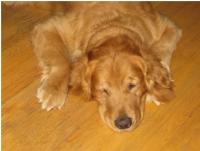Hypothyroidism
Hypothyroidism (low thyroid) is a disease of middle to older age dogs and is rare in cats. It is due to a low amount of thyroid hormone.
The hormone comes from the thyroid glands in the neck. It is usually caused by inflammation destroying some of the thyroid tissue. Sometimes the gland starts to shrink. Low thyroid levels affect all the organs and slow down metabolism.
Common signs
Signs of a low thyroid include listlessness, weight gain, mental dullness, thin hair coat, a thickened skin, dry skin or coat, excessive shedding, darker skin color, reproductive problems, a puffy look to the head, ear or skin infections, aggression, the dog acts cold or in extreme cases, coma.
Diagnosis
Diagnosis is by measuring the thyroid hormone in the blood. Dogs with hypothyroidism have a low level. However, it’s not always that simple.
Other medical problems and some drugs can lower the hormone level in a normal dog. This is common with skin problems. A low thyroid can cause some skin problems, and some skin problems can lower thyroid levels. It’s your classic Catch-22!
Testing
There are different types of tests that check the thyroid. Testing a free T4 level instead of a total T4 is better.
A Free T4 test is more likely to tell you whether the dog is truly hypothyroid. About 80% of the dogs with a thyroid problem will also have a high cholesterol level. This can help make an accurate diagnosis. Some dogs will also be anemic. However, with difficult to diagnose cases, yet another test, known as a thyroid stimulating hormone test, is available as well.
Treatment
Treatment is with thyroid hormone, levothyroxine, given once or twice a day. Your dog will need medicine for the rest of his life. The medicine is not fixing the thyroid gland. You are just giving the hormone your dog’s body can’t make.
Follow-up
Your dog’s thyroid level will be tested on a regular basis. This is to make sure you are giving the proper amount of medicine. It will take a month or two for your dog’s body to get back to normal. However, many dogs have more energy sooner than that. Your dog may also suddenly shed a lot more as new hair grows in.
With proper treatment, your dog will have a normal life span.
All articles are reviewed and maintained by whiskerDocs team of veterinary experts.



